hood open OLDSMOBILE SILHOUETTE 1996 Owners Manual
[x] Cancel search | Manufacturer: OLDSMOBILE, Model Year: 1996, Model line: SILHOUETTE, Model: OLDSMOBILE SILHOUETTE 1996Pages: 372, PDF Size: 19.39 MB
Page 90 of 372
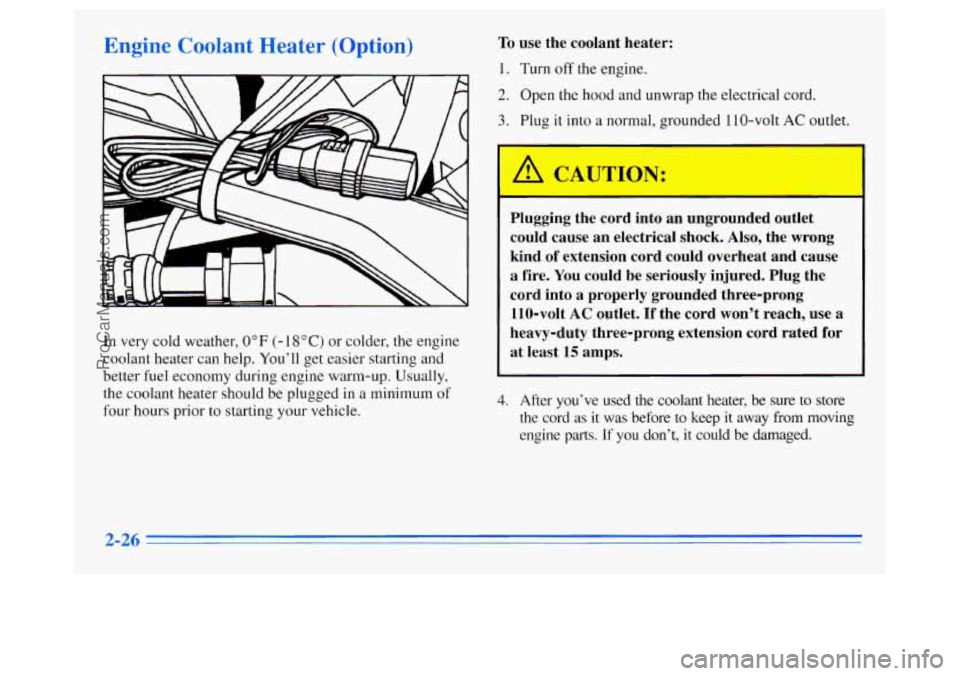
In very cold weather, 0°F (- 18°C) or colder, the engine
coolant heater can help. You’ll get easier starting and
better fuel economy during engine warm-up. Usually,
the coolant heater should be plugged
in a minimum of
four hours prior to starting your vehicle.
To use the coolant heater:
1. Turn off the engine.
2. Open the hood and unwrap the electrical cord.
3. Plug it into a normal, grounded 110-volt AC outlet.
I
t
Plugging the cord into an ungrounded outlet
could cause an electrical shock.
Also, the wrong
kind
of extension cord could overheat and cause
a fire. You could be seriously injured. Plug the
cord into a properly grounded three-prong 110-volt
AC outlet. If the cord won’t reach, use a
heavy-duty three-prong extension cord rated for
at least 15 amps.
4. After you’ve used the coolant heater, be sure to store
the cord as
it was before to keep it away from moving
engine parts.
If you don’t, it could be damaged.
ProCarManuals.com
Page 216 of 372
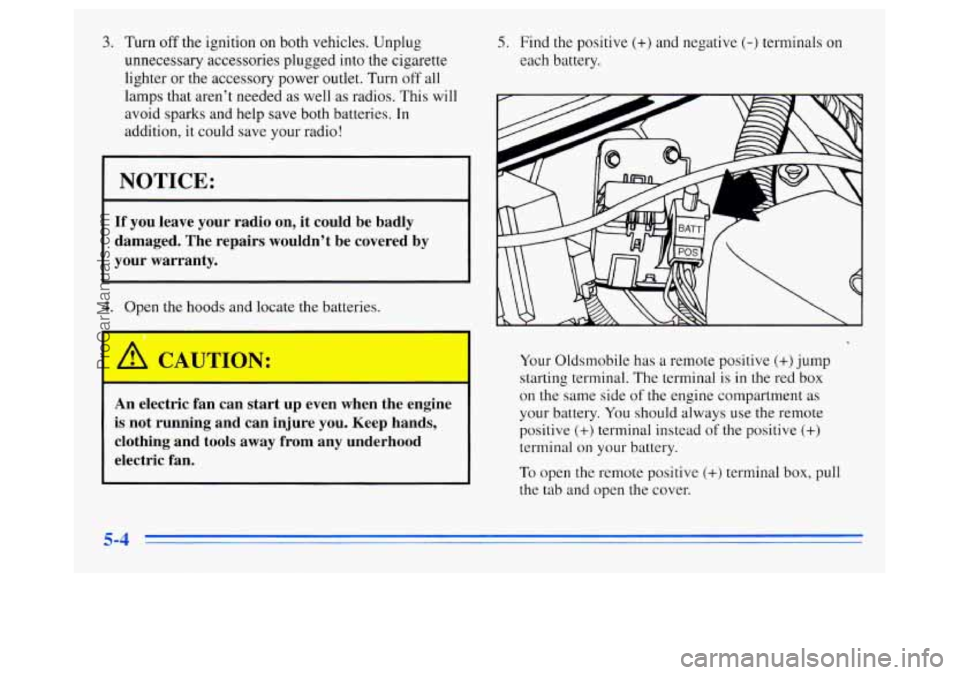
3. Turn off the ignition on both vehicles. Unplug
unnecessary accessories plugged into the cigarette
lighter or the accessory power outlet. Turn
off all
lamps that aren’t needed as well as radios. This will
avoid sparks and help save both batteries.
In
addition, it could save your radio!
I NOTICE:
If you leave your radio on, it could be badly
damaged. The repairs wouldn’t be covered by
your warranty.
4. Open the hoods and locate the batteries.
An electric fan can start up even when the engine
is not running and can injure you. Keep hands,
clothing and tools away from any underhood
electric fan.
-1
5. Find the positive (+) and negative (-) terminals on
each battery.
Your Oldsmobile has
a remote positive (+)jump
starting terminal. The terminal is
in the red box
on the same side
of the engine compartment as
your battery. You should always use the remote
positive
(+) terminal instead of the positive (+)
terminal on your battery.
To open the remote positive
(+) terminal box, pull
the tab and open the cover.
5-4
ProCarManuals.com
Page 225 of 372
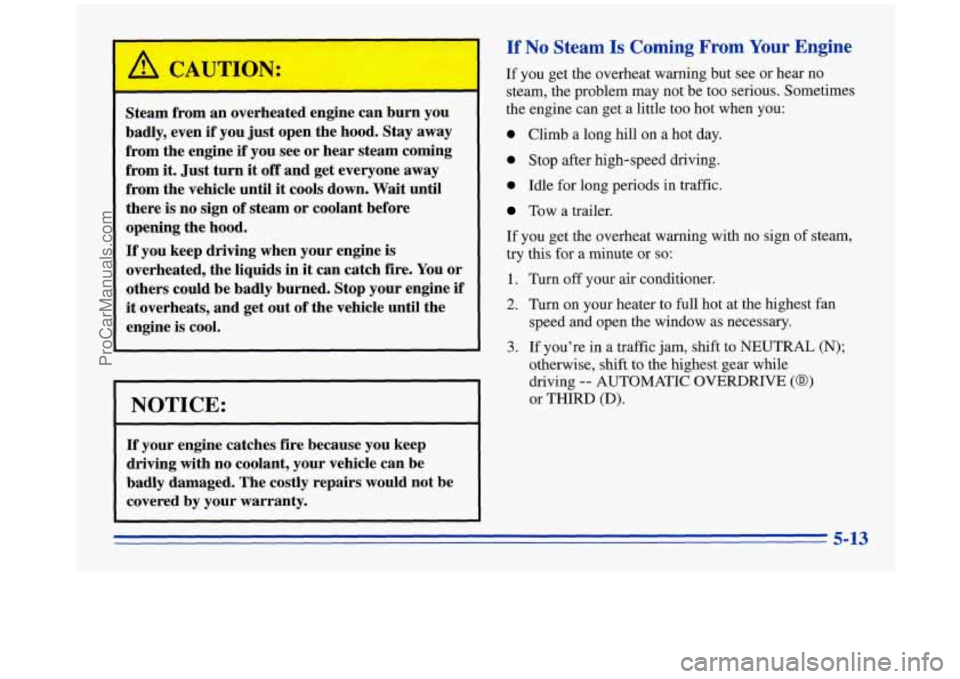
/11 CA JTILV:
Steam from an overheated engine can burn you
badly, even if you just open the hood. Stay away
from the engine
if you see or hear steam coming
from it. Just turn
it off and get everyone away
from the vehicle until it cools down. Wait until
there is no sign of steam or coolant before
opening the hood.
If you keep driving when your engine is
overheated, the liquids
in it can catch fire. You or
others could be badly burned. Stop your engine if
it overheats, and get out of the vehicle until the
engine is cool.
I NOTICE:
r
~ ~~
If your engine catches fire because you keep
driving with no coolant, your vehicle can be
badly damaged. The costly repairs would not be
covered
by your warranty.
If No Steam Is Coming From Your Engine
If you get the overheat warning but see or hear no
steam, the problem may not be too serious. Sometimes
the engine can get a little too hot when you:
0 Climb a long hill on a hot day.
0 Stop after high-speed driving.
0 Idle for long periods in traffic.
Tow a trailer.
If you get the overheat warning with no sign of steam,
try this for a minute or so:
1. Turn off your air conditioner.
2. Turn on your heater to full hot at the highest fan speed and open the window as necessary.
3. If you’re in a traffic jam, shift to NEUTRAL (N);
otherwise, shift to the highest gear while
driving
-- AUTOMATIC OVERDRIVE (@)
or THLRD (D).
ProCarManuals.com
Page 253 of 372
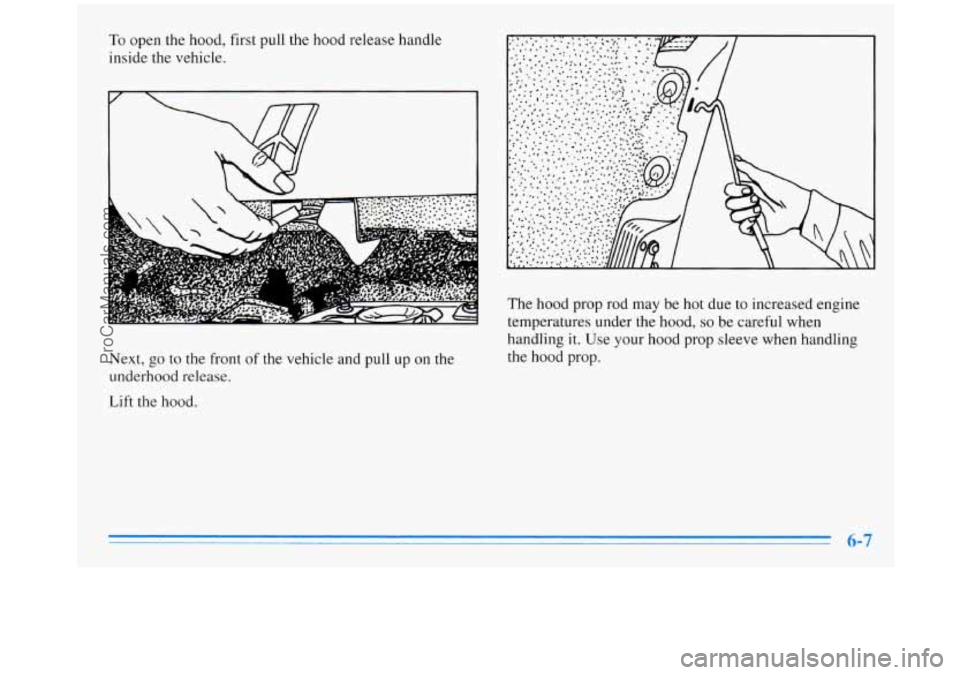
To open the hood, first pull the hood release handle
inside the vehicle.
Next, go to
the front of the vehicle and pull up on the
underhood release.
Lift
the hood. The
hood prop rod may be
hot due to increased engine
temperatures under the hood,
so be careful when
handling
it. Use your hood prop sleeve when handling
the hood prop.
ProCarManuals.com
Page 255 of 372
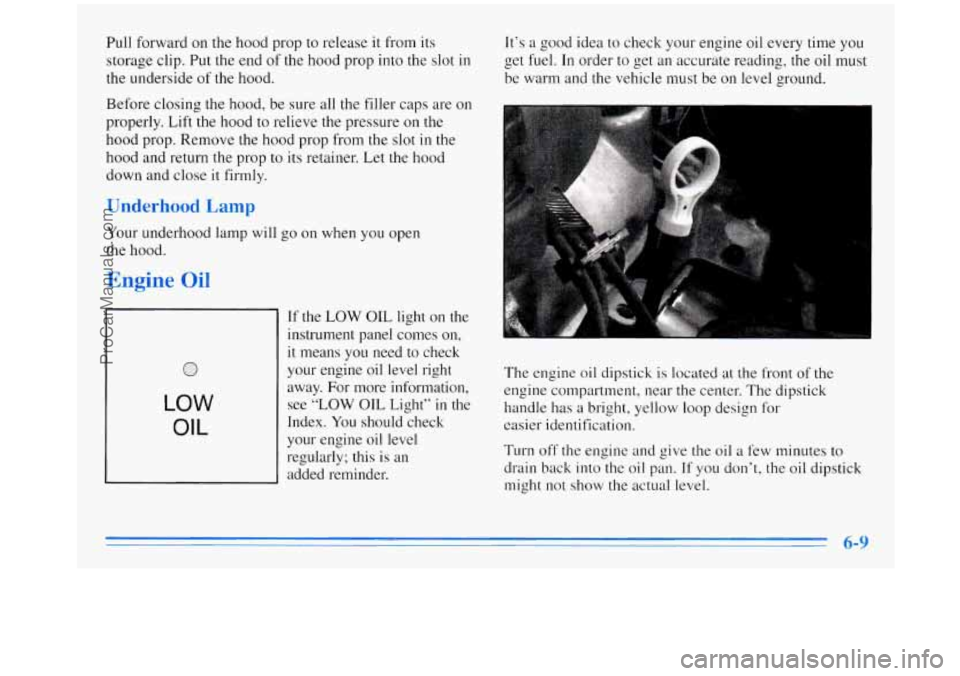
Pull forward on the hood prop to release it from its
storage clip.
Put the end of the hood prop into the slot in
the underside of the hood.
Before closing the hood, be sure all the filler caps are on
properly. Lift the hood to relieve the pressure on
the
hood prop. Remove the hood prop from the slot in the
hood and return the prop to its retainer. Let the hood
down and close
it firmly.
Underhood Lamp
Your underhood lamp will go on when you open
the hood.
Engine Oil
LOW
OIL
If the LOW OIL light on the
instrument panel comes
on,
it means you need to check
your engine oil level right
away.
For more information,
see "LOW
OIL Light" in the
Index. You should check
your engine oil level
regularly; this is
an
added reminder. It's
a good idea
to check your engine oil every time you
get fuel.
In order to get an accurate reading, the oil must
be warm and the vehicle must be on level ground.
.-
The engine oil dipstick is located at the front of the
engine compartment, near the center. The dipstick
handle has
a bright, yellow loop design for
easier identification.
Turn off the engine
and give the oil a few minutes to
drain back into the
oil pan. If you don't, the oil dipstick
might not show the actual level.
ProCarManuals.com
Page 303 of 372

Anti-Lock Brake System (ABS ‘unction Block Fuse Injector Fuse
You’ll find this fuse under the hood in the ABS junction
block, located next to the remote positive jump
starting terminal.
To open the junction block, press in on both sides of
the cover. This fuse
is located under the hood, on a bracket
just
behind the passenger’s side headlamp. It
is mounted on the
face of the bracket in the position closest to
the passenger’s
side of the vehicle. The fuse services the injectors, fuel
pump, oil pressure sender and fuel pump switch.
To access the fuse, pry back the latch with a screwdliver,
then pull down on
the base of the unit. If you need to replace
the fuse, be sure to use one with the same amperage.
Push
the base of the unit firmly into the cover until the
latch snaps into
the locked position.
6-57
ProCarManuals.com
Page 341 of 372

At Least Nice a Year At Least Once a Year
Restraint System Check
Make sure the safety belt rem’ mder
light and all your
belts, buckles, latch plates, retractors and anchorages are
working properly.
If your vehicle has a built-in child
restraint, also periodically make sure the harness straps,
latch plates, buckle, clip, child head restraint and
anchorages are working properly.
Look for any other
loose or damaged safety belt and built-in child restraint
system parts.
If you see anything that might keep a
safety belt or built-in child restraint system from doing
its
job, have it repaired. Have any torn or frayed safety
belts or harness straps replaced.
Also look for any opened or broken air bag covers, and
have them repaired or replaced. (The air bag system
does
not need regular maintenance.)
Automatic Transaxle Check
Check the transaxle fluid level; add if needed. See
“Automatic Transaxle” in the Index.
A fluid loss
may indicate a problem. Check
the system and repair
if needed.
Key Lock Cylinders Service
Lubricate the key lock cylinders with the lubricant
specified
in Part D.
Body Lubrication Service
Lubricate all body door hinges, including the liftgate.
Also lubricate all hinges and latches, including those for
the hood, sliding door track, rear compartment, glove box
door, console door, and any folding seat hardware. Part
D
tells you what to use. More frequent lubrication may be
required when exposed to a corrosive environment.
7-
ProCarManuals.com
Page 363 of 372

FogLamps .................................... 2-49
Foreign Countries. Fuel
........................... 6-3
Four-Way Manual Seat
........................... 1 - I
FrontDoor ..................................... 2-3
Front Sidemarker Lamp Bulb Replacement
........... 6-30
FrontTowing
................................... 5-9
Front Turn Signal Lamp Bulb Replacement
.......... 6-30
Fuel
.......................................... 6-2
Filling Your Tank
.............................. 6-4
Gage
....................................... 2-83
In Foreign Countries
........................... 6-3
Fuses and Circuit Breakers
....................... 6-53
Gages Engine Coolant Temperature
.................... 2-76
Engine Oil Pressure
........................... 2-80
Fuel
....................................... 2-83
Speedometer
................................. 2-71
Tachometer
.................................. 2-71
Voltmeter
................................... 2-74
Garage Door Opener
............................ 2-54
Gear Positions. Automatic Transaxle
................ 2-27
GloveBox
.................................... 2-57
Gross Axle Weight Rating
........................ 4-27
Gross Vehicle Weight Rating
...................... 4-27
GAWR
....................................... 4-27
GVWR
....................................... 4-27 Halogen
Bulbs
................................ 6-29
Hazard Warning Flashers
.......................... 5-1
Head Restraints ................................. 1-4
Headlamps
.................................... 2-48
Bulb Replacement
............................ 6-29
HighLow Beam Changer
...................... 2-40
OnReminder
................................ 2-48
Wiring
..................................... 6-52
Hearing Impaired. Customer Assistance
.............. 8-3
Heating
........................................ 3-3
High-Beam Headlamps
.......................... 2-40
Highway Hypnosis
.............................. 4-21
Hill and Mountain Roads
......................... 4-21
Hitches. Trailer
................................. 4-33
Hood Checking Things Under
......................... 6-6
Prop
........................................ 6-7
Release
...................................... 6-6
Horn ......................................... 2-38
Hydroplaning
.................................. 4-17
Ignition Positions
.............................. 2-23
Illuminated Entry
.......................... 2- 1 1. 2-50
Inflation. Tire
.................................. 6-36
Inflator. Air
................................... 2-66
Injector Fuse
................................... 6-57
Inside Daymight Rearview Mirror
................. 2-52
ProCarManuals.com